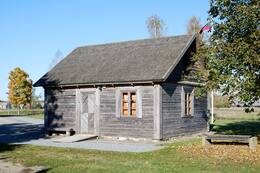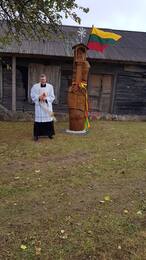Congress of Lithuanian Partisan Commanders
III National Partizans
Lithuania began to resist the Soviet occupation with weapons in 1944 and the organized struggle lasted until 1953, when the Lithuanian partisan structures were destroyed. The first partisan units began to form in the late summer of 1944, and later they grouped into larger organizational units: teams, districts, and areas were formed. The aim was to unite the military territorial partisan structures operating in occupied Lithuania, to establish an organization that would fight for the liberation of the country by political and military means, and to form a joint political and military leadership of the armed resistance.
Lithuanian Partisan Leaders' Congress, a meeting of representatives of the Lithuanian resistance to the Soviet occupation regime, mostly partisan leaders. Held on 02/22/1949 in the village of Minaičiai (Radviliškis rural municipality); meetings were held on 02/10/20. The meetings and discussions were held in the Prisikėlimų district headquarters bunker located in the Antanina and Stanislovas Mikniai homestead. 8 people officially participated in the meetings. The congress announced the establishment of a unified resistance organization - the Lithuanian Freedom Struggle Movement, adopted a political declaration (Declaration of the Council of the Lithuanian Freedom Struggle Movement), and considered more than 20 issues of the restoration of Lithuanian statehood, the organization and tactics of resistance to the Soviet occupation regime. It was decided to declare the slogan of the Movement: Give to the Homeland what you must! After the congress of partisan commanders, the armed resistance became a well-organized military structure, carrying out the self-defense of the Lithuanian state against the aggressor - the USSR. Later (around 1950) due to intensive attacks against the partisans, the resistance movement was almost suppressed. In 2003, a monumental composition was unveiled in the village of Mėnaičiai, at the homestead of J. Mikniūtė-Petrėnienė, in memory of the congress and the Lithuanian freedom struggle movement.
More information sources
Related timeline
Related objects
Sąjūdis Memorial to Lithuanian Freedom Fighters in Minaičiai (Minaičiai Bunker-Museum)
In the autumn of 1948, the farm of partisan supporters A. and S. Mikniai in the village of Minaičiai (Radviliškis district) was chosen as the wintering place for the Prisikėlimo Military District headquarters. The partisans dug a small bunker under the barn to house the staff of the district.
On 16 February 1949, the partisan commanders in Minaičiai finalised and published the declaration of the Lithuanian freedom struggle “Sąjūdis”. The main aim of the Declaration was to restore Lithuania to a parliamentary republic (as it was from 1920–1926). Eight people formally attended the meetings: Jonas Žemaitis- Vytautas, Juozas Šibaila-Merainis, Petras Bartkus-Žadgaila, Adolfas Ramanauskas-Vanagas, Aleksandras Gribinas-Faustas, Vytautas Gužas-Kardas, Leonardas Grigonis-Užpalis, and Bronius Liesys-Naktis.
The bunker was also used later. A partisan pharmacist Izabelė Vilimaitė-Stirna treated partisan Laurynas Mingilas-Džiugas, who was seriously wounded in the Battle of Užpelkiai. In 1953, the unoccupied bunker caved in and the owners earth-filled it.
In 2010, the work on the restoration of the partisan bunker and barn, as well as the construction of the monument began. The monument, created by sculptor Jonas Jagėla, bears the names of the partisans who signed the Declaration. An authentic, glassroofed partisan bunker has been built in the barn, and the visitors are provided an opportunity to see it from above; there is also an exhibition in the barn.
Partisan liaison officer's homestead in Saiai
The homestead of the partisan supporters of the Sajės in Balandiškis, Grinkiškis eldership, Radviliškis district, is connected with the struggles for freedom in Lithuania. Its history is usually presented together with the Mikniai homestead, located in nearby Minaičiai (Lithuanian Freedom Movement Memorial).
This secluded and modest homestead, according to the recollections of Viktoras Šniuolis-Vitvytis, an eyewitness to the events, and confirmed by some research, was the place where the founding documents of the Lithuanian Freedom Struggle Movement (LLKS) were probably prepared. The LLKS became the most important organization of resistance to the Soviet occupation, covering the entire territory of Lithuania. It is reported that since 1946, freedom fighters had been visiting this homestead to rest and get some strength. After the partisan liaisons held a congress of partisan commanders at the Mikniai homestead in February 1949, the headquarters of the LLKS Public Division operated in the Sajai homestead (in a bunker installed in a barn), and the LLKS periodical, the newspaper "Prie rymancių rūpintojėlio", was published.
Partisans visited the bunker of the Sajai homestead many times, wintered there, or were treated for injuries. The hearth of freedom existed in the Sajai homestead until 1952. In the autumn of that year, the bunker was discovered, and the owners of the homestead were arrested.
Currently, the homestead is almost completely dilapidated, but it contains a monument, an information stand, and a chapel pillar to commemorate important historical events that took place at this location.
Monument to the partisans of the Resurrection District in Šeduva
On October 14, a monument to the partisans of the Resurrection District was unveiled in Šeduva Laisvės Square. The authors of the monument: sculptor Romanas Kazlauskas, architects Arūnas Eduardas Paslaitis and Viktorija Paslaitytė. It is a joint work of the Lithuanian Genocide and Resistance Research Center (LGGRTC) and the Radviliškis District Municipality.
Monument to the Partisans of the Resurrection District, commemorating all Lithuanian partisans who fought and died in this district in 1944-1953.
This is another monument dedicated to the memory of the Lithuanian partisan districts. The following districts have already been immortalized: Algimantas – Troškūnai, Anykščiai district, Didžioji Kova – Gelvonai, Širvintos district, Tauras – Marijampolė, Žemaičiai – Telšiai and Vytis – Vadokliai, Panevėžys district.
Lithuanian Partisan Memorial in Kryžkalnis
The memorial is located in Kryžkalnis, near the intersection of important roads. The large sword-shaped obelisk marking the memorial is clearly visible when driving along the Klaipėda-Vilnius highway near Kryžkalnis.
The Partisan Memorial is dedicated to honoring the Lithuanian partisans who fought against the Soviet occupation in the post-war period for an independent Lithuania. It is one of the largest places in Lithuania that commemorates the sacrifice and memory of the partisans.
The memorial, created by sculptor Tadas Gutauskas and architect Saulius Pamerneckis, was opened on September 20, 2020. It not only commemorates the victims of the past, but also invites visitors to remember the price of freedom and be proud of their country's history.
The memorial consists of three parts: a 25-meter-high sword-shaped obelisk, which symbolizes the strength and fighting spirit of the partisans, as well as a memorial wall, on which are engraved the names of about 20,000 fallen partisans, arranged in steles in the shape of a Vytis cross, and the Square of Honor with the Tomb of the Unknown Partisan, which symbolizes all those who are unknown and unrecorded, but who sacrificed their lives for Lithuania.
Related stories
A fateful meeting in a bunker: the 1949 Congress of Lithuanian Partisan Commanders
On February 10-20, 1949, the only congress of partisan commanders in occupied Lithuania took place in the Mikniai farmstead bunker in the Minaičiai village of Radviliškis district, during which the Lithuanian Freedom Struggle Movement (LLKS) was founded and the Declaration of Independence was proclaimed.
The Last Battle in the Swamp Forest
On August 13, 1949, a fateful battle took place in Radviliškis County, in the Užpelkės Forest, during which Bronius Liesys-Naktis, a member of the Presidium of the Council of the Lithuanian Red Army and a signatory of the February 16 Declaration, was killed, along with other partisans of the Prisikėlimų district.







